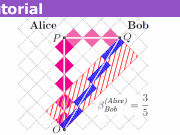Why There Are Maximum Mass Limits for Compact Objects
In this article, we will look at why there are maximum mass limits for objects that are supported against gravity by degeneracy pressure instead of kinetic pressure. We will look at the two known cases of this, white dwarfs and neutron stars; but it should be noted that similar arguments will apply to any postulated object that meets the general definition given above. For example, the same arguments would apply to “quark stars” or “quark-gluon plasma objects”, etc.
Table of Contents
The Chandrasekhar Limit
First, we’ll look at the maximum mass limit for white dwarfs, the Chandrasekhar limit. (Note that the first derivation we will give below, using the TOV equation, is a simplified version of the argument given in Shapiro & Teukolsky, who use numerical integration of the Lane-Emden equation. For this article we will be satisfied with a heuristic argument using averages and won’t need to go to that extreme.)
We start with the general relativistic equation for hydrostatic equilibrium for a static, spherically symmetric object (we will not consider the rotation of neutron stars here; that complicates the math and changes the numerical value of the maximum mass limit, but it does not remove it). This is the Tolman-Oppenheimer-Volkoff equation, which we will write in a form somewhat different from the one in which it usually appears. Note that we are using units in which ##G = c = 1##.
$$
\frac{dp}{dr} = – \rho \frac{m}{r^2} \left( 1 + \frac{p}{\rho} \right) \left( 1 + \frac{4 \pi r^3 p}{m} \right) \left( 1 – \frac{2m}{r} \right)^{-1}
$$
This form of the equation makes it easier to see that what we have here is the Newtonian (non-relativistic) equation for hydrostatic equilibrium, with some relativistic correction factors. For white dwarfs, however, it turns out that we can ignore all of those correction factors and just look at the non-relativistic formula for hydrostatic equilibrium. This is because the radius of white dwarfs is much larger than their mass in geometric units, so ##r >> 2m## and the last factor on the RHS above can be taken to be ##1##, and their pressure is always too small to make the correction terms in the other two factors significant, so those factors can also be taken to be ##1##.
We now make use of the fact that, for degenerate matter, we have ##p = K \rho^\Gamma##, where ##K## is a constant that depends on whether the degeneracy is non-relativistic or relativistic, so we’ll designate its two values as ##K_\text{n}## and ##K_\text{r}## (we will only consider the two extremes and will not look at the transition between them), and ##\Gamma## is the “adiabatic index”, which is ##5/3## in the non-relativistic limit and ##4/3## in the relativistic limit. This gives ##dp / dr = K \Gamma \rho^{\Gamma – 1} d \rho / dr##. Finally, we make use of the fact that, for a static, spherically symmetric object, ##dm / dr = 4 \pi \rho r^2##, to put things in terms of derivatives of ##m##.
We plug all this into the non-relativistic hydrostatic equilibrium equation to obtain:
$$
\frac{d}{dr} \left( \frac{1}{4 \pi r^2} \frac{dm}{dr} \right) = – \frac{1}{K \Gamma} \left( \frac{1}{4 \pi r^2} \frac{dm}{dr} \right)^{2 – \Gamma} \frac{m}{r^2}
$$
Expanding and simplifying gives:
$$
\frac{d^2 m}{dr^2} – \frac{2}{r} \frac{dm}{dr} + \frac{\left( 4 \pi \right)^{\Gamma – 1}}{K \Gamma} \left( \frac{1}{r^2} \frac{dm}{dr} \right)^{2 – \Gamma} m = 0
$$
Rather than try to solve this nasty differential equation directly, we will be satisfied here with making rough order of magnitude estimates. For this purpose, we define ##M## as the total mass of the white dwarf and ##R## as its surface radius, and we approximate ##dm / dr## with its average, ##M / R##, and ##d^2 m / dr^2## with ##M / R^2##. Substituting these into the above equation gives, after simplifying:
$$
M^{2 – \Gamma} = \frac{K \Gamma}{\left( 4 \pi \right)^{\Gamma – 1}} R^{4 – 3 \Gamma}
$$
Now we are in a position to look at our two regimes. In the non-relativistic regime, ##\Gamma = 5/3## and we have:
$$
M^{1/3} = \frac{5}{3} \frac{K_\text{n}}{\left( 4 \pi \right)^{2/3}} \frac{1}{R}
$$
Inverting this tells us that, as ##M## increases, ##R## decreases as the cube root of ##M##. In other words, as the white dwarf gets more massive, it gets more compact. And as it gets more compact, its density and pressure increase and it becomes relativistic. So in order to assess whether there is a maximum mass limit, we need to look at the relativistic regime. Here, ##\Gamma = 4/3## and we have:
$$
M^{2/3} = \frac{4}{3} \frac{K_\text{r}}{\left( 4 \pi \right)^{1/3}}
$$
Note that now, ##R## does not appear at all in the equation! It is just an equation for ##M## in terms of known constants. In other words, in the ultra-relativistic limit, ##M## approaches a constant limiting value and cannot exceed it. That value is the Chandrasekhar limit. (Note that, to get the actual numerical value for the limit that is used by astrophysicists, which is 1.4 solar masses, the rough order of magnitude calculation we have done here is not enough, but we won’t go into further details about how that value is actually calculated here. Our purpose here is simply to see, heuristically, why there must be a mass limit at all.)
Let’s take a step back now and try to understand what is going on here. One way of looking at it is to ask the question: what is the white dwarf’s strength of gravity as a function of density? By “strength of gravity” here we mean, heuristically, the inward pull that must be balanced by the outward force of pressure in order to maintain hydrostatic equilibrium. It turns out that this increases with density as ##\rho^{4/3}##. So we should expect that in any situation in which ##\Gamma \to 4/3##, there will be a maximum mass limit because pressure can no longer continue to increase faster than gravity. And we can see from the above that a relativistically degenerate electron gas, as in a white dwarf, is one such situation. (Another turns out to be a supermassive star supported by radiation pressure; as the mass increases, the effective ##\Gamma## for radiation pressure becomes relativistic and we have the same qualitative situation as a white dwarf, though of course with different constants so the actual numerical value of the mass limit is different.)
This argument about the strength of gravity can in fact be made mathematically. As Shapiro and Teukolsky note, the first physicist to do this was Landau, in 1932, who came up with an alternate way of understanding Chandrasekhar’s result, published the year before, on the maximum mass of white dwarfs. Landau’s argument is straightforward: first, we find an expression for the total energy ##E## (excluding rest mass energy) of an object that is supported by degeneracy pressure; then we look to see under what conditions ##E## will have a minimum, which indicates a stable equilibrium.
The total energy has two components: the (positive) energy of the fermions due to the degeneracy pressure, and the (negative) gravitational potential energy due to the mass of the star. The energy due to degeneracy pressure is the Fermi energy ##E_F## per fermion, and we can use the Newtonian formula for the gravitational potential energy per fermion since we saw above that the relativistic corrections to the TOV equation, which are of the same order of magnitude as the relativistic corrections to the gravitational potential, are negligible. The total energy per fermion, therefore, looks like this (I am writing this in a slightly different from that used in Shapiro & Teukolsky, for easier comparison to the derivation given above):
$$
E = \frac{\hbar M^{1/3}}{\mu_B^{1/3} R} – \frac{M \mu_B}{R}
$$
where ##\mu_B## is the baryon mass that is associated with the fermions providing the degeneracy pressure; this will be the average of the proton and neutron mass in a typical white dwarf, since each electron is associated with one proton and the proton-neutron ratio is approximately ##1##. (In a neutron star ##\mu_B## would just be the neutron mass.)
For there to be a stable equilibrium at a given value of ##M##, there must be a minimum of ##E## at a finite value of ##R##. This will occur if we have ##dE / dR = 0## at a finite value of ##R##. Since both terms in ##E## scale as ##1 / R##, the expression for ##dE / dR## is simple:
$$
\frac{dE}{dR} = – \frac{1}{R^2} \left( \frac{\hbar M^{1/3}}{\mu_B^{1/3}} – M \mu_B \right)
$$
Now we look at how ##dE / dR## varies with ##M##. If ##M## is small, the factor inside the parentheses will be positive, so ##dE / dR## will be negative and ##E## will decrease with increasing ##R##. That will make the star less relativistic and eventually nonrelativistic. Once the star becomes nonrelativistic, the radial dependence of the Fermi energy will change; it will scale as ##1 / R^2## instead of ##1 / R##. This means that the gravitational potential energy will, at some value of ##R##, become larger than the Fermi energy, and that will cause the sign of ##dE / dR## to flip from negative to positive since the gravitational potential energy increases with increasing ##R## (to a limiting value of ##0## as ##R \to \infty##). The finite value of ##R## where the sign flip occurs will be a minimum of ##E## and therefore a stable equilibrium.
However, if ##M## is large, the factor inside the parentheses will be negative, so ##dE / dR## will be positive. In that case, ##E## can be decreased without bound by decreasing ##R##; both terms scale the same way with ##R## and decreasing ##R## makes the star more relativistic so the radial dependence of the Fermi energy will not change. That means there is no stable equilibrium; the star will collapse.
The boundary between these two regimes will occur at the value of ##M## at which the factor inside the parentheses above is zero, and that will be the maximum possible mass, which will be given by:
$$
M^{2/3} = \frac{\hbar}{\mu_B^{4/3}}
$$
Comparing this with the heuristic formula above gives at least a rough order of magnitude estimate for the constant ##K_r##. Note, however, that this formula will be formally the same for a white dwarf and a neutron star; in fact, it will be the same for any object that is supported by degeneracy pressure, since we made no assumptions that were specific to a particular type of object. The only difference between different types of objects will be a different value of ##\mu_B## based on chemical composition. This formula itself is heuristic, and there turn out to be other numerical factors involved; however, it will indeed turn out that the suggestion implied by the above formula, that the maximum mass of a neutron star is not that different from the maximum mass of a white dwarf, is basically correct.
Of course, as we noted earlier, to actually calculate the commonly known numerical value of the Chandrasekhar limit for white dwarfs, the above formulas are not enough; we would have to do more complicated numerical calculations. Chandrasekhar did those calculations when he originally published his derivation of the limit that came to be named after him, in 1934; and subsequent calculations have not made any significant changes to the value he obtained. However, the numerical value does depend significantly on the chemical composition of the white dwarf. In terms of the first formula above, the chemical composition can affect the value of ##K_r##; in terms of the second, it can affect the value of ##\mu_B## according to the fraction of baryons that are protons. Chandrasekhar’s value assumed that the chemical composition of the white dwarf was mostly hydrogen and helium, and that is the basis for the commonly used value of 1.4 solar masses for his limit. However, later on in the 1950s, when Harrison, Wakano, and Wheeler were deriving a general equation of state for cold matter, they used a different chemical composition for white dwarfs, one that was significantly richer in neutrons, and obtained a value of 1.2 solar masses. So when looking at values in the literature for white dwarf maximum mass limits, one has to be sure to check the chemical composition that is being assumed.
The Tolman-Oppenheimer-Volkoff Limit
In 1938, Tolman, Oppenheimer, and Volkoff investigated the question of maximum mass limits for neutron stars. It was in the course of these investigations that they derived the relativistic equation for hydrostatic equilibrium that we saw in the previous article, and which is named after them. They went through a derivation similar to the one Chandrasekhar had done for white dwarfs and came up with a similar result: there is a maximum mass limit for neutron stars. In terms of the above formulas, the only change would be a different value of ##K_r## in the first formula, or ##\mu_B## in the second, to account for the change in the type of fermions, from electrons to neutrons, and the fact that the same fermions now account for both the mass and the degeneracy pressure (whereas in a white dwarf, the electrons account for the degeneracy pressure while the baryons account for the mass).
The interesting part was that the numerical value of the mass limit that they obtained for neutron stars was 0.7 solar masses–i.e., smaller than the white dwarf limit that Chandrasekhar had calculated! The reason for this, in terms of the formulas we looked at above, is simple: in addition to the changes mentioned above, Oppenheimer and Volkoff did not assume that the relativistic correction factors in the TOV equation were negligible, as we did in the previous article. They included those factors, and for neutron stars in the relativistic limit, they are not all negligible; the end result is to increase the RHS of the TOV equation by a numerical factor that ends up appearing in the denominator of our formulas for the maximum mass and thus reduces the predicted maximum mass by about half.
At the time, this was not necessarily a major issue, since no neutron stars had been observed; but now we know of many neutron stars that are significantly more massive, so we know something must be wrong with the original TOV calculation. But even at the time, Tolman, Oppenheimer, and Volkoff had good reason not to take that number at face value. Why? Because, even though not a lot was known about the strong nuclear force at the time, it was evident that, at short enough distances, smaller than the size of an atomic nucleus, that force must become strongly repulsive; otherwise, atomic nuclei would not be stable at the size ranges they were known to have.
This matters because the derivations we went through above made an important assumption that we didn’t mention before: that the fermions in question did not interact with each other at all, except through the Pauli exclusion principle. If we add an interaction that is repulsive at short ranges, that changes things. In the first derivation above, the effect is to increase ##\Gamma##, the adiabatic index, above the normal value it would have due to degeneracy and the Pauli exclusion principle alone. In the second derivation, the effect is to add another positive term in the energy due to the repulsive interaction.
On the face of it, this would seem to indicate that the two derivations will now give us different answers! Increasing ##\Gamma## should mean that the first derivation now looks more like its nonrelativistic form, which does not lead to a maximum mass. However, adding a positive energy term in the second derivation does not change the overall logic leading to a maximum mass as long as that energy scales as ##1 / R##, which we would expect it to do. The effect will just be to increase the numerical value of the maximum mass that we calculate.
The resolution of this apparent contradiction between the two derivations is that, in the neutron star case, the “critical” value of ##\Gamma##, at which the star becomes unstable, is no longer ##4/3##, as it was for white dwarfs; that is only a limiting value in the absence of other interactions. In the presence of other interactions, the critical value of ##\Gamma## increases, to the point where even the larger actual value of ##\Gamma## due to the repulsive interactions is still less than the critical value of ##\Gamma## in the relativistic limit. And that means the same logic as before still goes through in the first derivation for neutron stars: in the relativistic limit, ##\Gamma## reaches a critical value at which the mass becomes independent of radius and there is a maximum mass.
Why must the value of ##\Gamma## in the first derivation for neutron stars always end up less than the critical value? The answer to this comes from looking at a limit that relativity imposes on the equation of state of any kind of matter: that the speed of sound in the matter cannot exceed the speed of light. The speed of sound is given by ##v_s^2 = dp / d\rho##, and we can see that, if ##p = K \rho^\Gamma##, the limit ##dp / d\rho \le 1## will force ##\Gamma## to decrease as the star becomes more and more massive and more and more compressed and ##\rho## therefore increases. So there is no way for the mass to increase indefinitely.
As we noted above, our conclusions here, while they should be general and apply to any equation of state, only give a rough order of magnitude estimates of numerical values. Physicists have done more detailed calculations using various equations of state for neutron star matter and have confirmed the existence of maximum mass limits for all of them, with values ranging from about 1.5 to about 2.7 solar masses. Analyses of the behavior of the critical value of ##\Gamma## have also been done using various models; in at least one case, the idealized case of a neutron star with uniform density, the calculations can be done analytically, without requiring numerical simulation, since closed form equations for this case are known. For this case, the critical point at which the limiting value of ##\Gamma## imposed by the condition that the speed of sound cannot exceed the speed of light is equal to the critical value of ##\Gamma## is at the point ##p = \rho / 3##, which agrees with the prediction from a perfect fluid model in the ultrarelativistic limit (for example, this is the same value that applies to a “gas” of photons). It is noteworthy that, for this case, the value of ##\Gamma## corresponding to this limit is very large, about ##3.5##. This confirms that even an extremely stiff equation of state is not sufficient to resist compression indefinitely in the relativistic limit.
Modern observations have found that the vast majority of neutron stars we observe are pulsars, rapidly rotating, and rapid rotation invalidates the calculations we have been making here since we assumed a static, spherically symmetric object. We would intuitively expect that rotation would compensate somewhat for increased gravity and therefore might increase the maximum mass limit, and indeed it appears to; we have observed pulsars at close to 3 solar masses, and no modern calculations for non-rotating neutron stars have indicated a limit that large. Calculations for rotating neutron stars are more complicated, but do not change the basic conclusion: there is still a maximum mass limit, and it is still fundamentally due to the same mechanism as above: that relativity places ultimate limits on the ability of degenerate matter to resist compression. That is a key reason why astrophysicists are highly confident that dark objects that are indirectly detected by their gravitational effects, and whose masses are estimated to be much larger than the maximum mass limit for neutron stars, are black holes.
A Final Note
As was mentioned above, there are other, more speculative configurations of degenerate matter proposed in the literature, such as “quark stars”, but they all are subject to the same general mechanism we have seen here for maximum mass limits. As compared to neutron stars, these speculative configurations are just changes in chemical composition, which can adjust the equations by numerical factors of order unity but cannot change the basic behavior. So, although such speculative objects, if they turn out to exist, might have maximum mass limits somewhat different from neutron stars, the differences will still be of order unity and will not affect the basic conclusion stated above, that when we detect the indirect gravitational effects of dark objects with masses much greater than the neutron star mass limit, those objects should be assumed to be black holes.
References:
Shapiro & Teukolsky, 1983, Sections 3.3, 3.4, 9.2, 9.3, 9.5, 9.6
- Completed Educational Background: MIT Master’s
- Favorite Area of Science: Relativity










Leave a Reply
Want to join the discussion?Feel free to contribute!